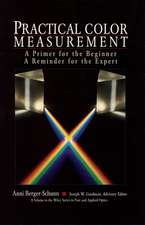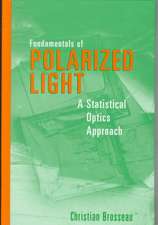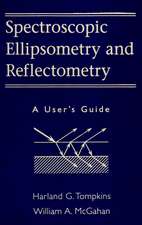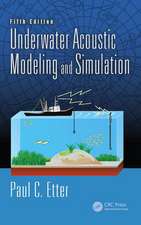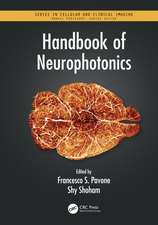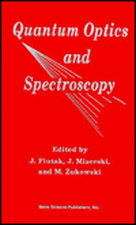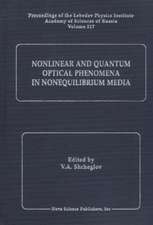Light Driven Micromachines
Autor George K. Knopf, Kenji Uchinoen Limba Engleză Hardback – 29 mar 2018
The book begins with the scientific background necessary to understand the nature of light and how light can initiate physical movement by inducing material deformation or altering the surrounding environment to impose micro-forces on the actuating mechanisms. The impact of physical size on the performance of light driven mechanisms and machines is discussed, and the nature of light–material interactions is reviewed. These interactions enable very small objects and mechanical components to be trapped and manipulated by a focused light beam, or produce local temperature gradients that force certain materials to undergo shape transformation. Advanced phase transition gels, polymers, carbon-based films and piezoelectric ceramics that exhibit direct light-to-mechanical energy conversion are examined from the perspective of designing optically driven actuators and mechanical systems. The ability of light to create photothermal effects that drive microfluidic processes and initiate the phase transformation of temperature sensitive shape memory materials are also explored in the book.
This compendium seeks to inspire the next generation of scientists and engineers by presenting the fundamental principles of this emerging interdisciplinary technology and exploring how the properties of light can be exploited for microfluidic, microrobotic, biomedical and space applications.
Preț: 1046.65 lei
Preț vechi: 1406.61 lei
-26% Nou
Puncte Express: 1570
Preț estimativ în valută:
200.27€ • 209.66$ • 165.72£
200.27€ • 209.66$ • 165.72£
Carte tipărită la comandă
Livrare economică 05-19 aprilie
Preluare comenzi: 021 569.72.76
Specificații
ISBN-13: 9781498757690
ISBN-10: 1498757693
Pagini: 333
Ilustrații: 16 Illustrations, color; 114 Illustrations, black and white
Dimensiuni: 156 x 234 x 30 mm
Greutate: 0.68 kg
Ediția:1
Editura: CRC Press
Colecția CRC Press
ISBN-10: 1498757693
Pagini: 333
Ilustrații: 16 Illustrations, color; 114 Illustrations, black and white
Dimensiuni: 156 x 234 x 30 mm
Greutate: 0.68 kg
Ediția:1
Editura: CRC Press
Colecția CRC Press
Cuprins
Preface. Nomenclature. 1.0 Introduction. 1.1 Brief History of Light and Optics – An Engineer’s Perspective. 1.2 Principles of Light Driven Mechanisms and Machines. 1.3 Designing Machines for the World of the Very Very Small. 1.3.1 Microtransducers: Sensors and Actuators (Interacting with the World). 1.3.2 Power, Control and Communication (Influencing the World). 1.3.3 Mechanical Micromechanisms (Structure and Form). 1.3.4 Integrated Nano and Micro Electromechanical Systems (Systems Approach). 1.3.5 Molecular Machines (How Small is Small?). 1.4 Role of Materials Engineering in Micromachine Design. 1.5 Practical Aspects of Optically Driven Microsystems. 1.6 Roadmap for this Book. 2.0 Harnessing the Forces of Light. 2.1 The Nature of Light. 2.1.1 Wave-Particle Behavior of Light. 2.1.2 Sources of Natural and Artificial Light. 2.1.3 Light Polarization. 2.1.4 Coherent and Incoherent Sources. 2.1.5 Absorption and Emission of Radiation. 2.2 Forces Generated by a Photon Stream (Radiation Pressure). 2.3 Coherent Light-Material Interactions. 2.3.1 Laser Beam Properties. 2.3.2 Shaping Laser Beams. 2.3.3 Energy Transfer: Physics of Illumination and Surface Interaction. 2.3.4 Heating, Melting and Vaporization. 2.4 Power Delivery and Machine Control Using Lasers. 3.0 Trapping, Tweezing and Manipulating Objects in a Light Beam. 3.1 Principles of Optical Scattering and Gradient Forces. 3.2 Optical Trapping and Tweezing. 3.3 Microcantilever Displacement using Optical Gradient Forces. 3.3.1 Nanomechanical Beam Resonators. 3.3.2 Photonic Switches and Circuits. 3.4 Optical Microflow Control, Mixing and Pumping. 3.4.1 Microfluidic Valves, Turbines and Pumps. 3.4.2 Microrotors Driven by Angular Momentum. 3.4.3 Microscale Paddle-Wheels3.5 Microfabrication of Optically Driven Mechanical Mechanisms. 3.5.1 Two-Photon Microfabrication of 3D Micromachines. 3.5.2 Microassembly using Optical Trapping and Tweezing. 3.6 Controlling Micromachines Using Light Beams. 4.0 Smart Materials that Respond to Light. 4.1 Materials that Exhibit Optical-to-Mechanical Energy Conversion Properties. 4.2 Photoresponsive Shape Changing Polymers. 4.2.1 Liquid Crystal Polymers. 4.2.2 Single DNA Molecular Nanomotors. 4.2.3 Molecular Photoswitch. 4.3 Optomechanical Stresses and Strains. 4.3.1 Photostrictive Materials (Photovoltaic & Inverse Piezoelectric Effects). 4.3.2 Charge Induced Surface Photomechanical Actuators. 4.3.3 Photo-induced Optical Anisotropy in ChG Films. 4.4 Photomechanical Actuation by Carbon Nanotubes 4.5 Electron Mediated Optical Microcantilever. 4.6 Advanced Intelligent Material Systems. 5.0 Optically Driven Photothermal Actuation. 5.1 Heating of Gases, Liquids and Solids with Light. 5.2 Optothermal Expansion of Fluids. 5.2.1 Ideal Gas Law (Relationship between Pressure, Volume and Temperature). 5.2.2 Flexible Membranes and Diaphragms (Indirect Optical Actuators). 5.2.3 Optofluidic Valves and Pumps. 5.2.4 Modular Opto-pneumatic Systems and Machines. 5.3 Photothermal Expansion of Phase Transformation Solids. 5.3.1 Shape Memory Alloys as Light Driven Actuators. 5.3.2 Reciprocal and Rotational Motion. 5.4 Magnetic Levitation by Temperature Sensitive Ferrites. 5.5 Photothermal Vibration of Optical Waveguides. 5.6 Engineering Requirements and Limitations of Photothermal Drive Mechanisms. 6.0 Light Driven Micro-systems and Micromachines. 6.1 Light Driven Microfluidic and Lab-on-Chip Systems. 6.1.1 Direct Manipulation of Liquids, Gels and Solids. 6.1.2 Transporting Liquid Droplets Using Opto-Electrowetting. 6.1.3 Optically Driven Proton Pumps. 6.1.4 Optical Scalpels. 6.1.5 Optical
Recenzii
"The book is beneficial to all researchers in the area of optics, since the subject of the book is developing very fast due to advanced micro- and nanotechnologies."
--Mircea Dragoman, National Research Institute in Microtechnology, Romania
--Mircea Dragoman, National Research Institute in Microtechnology, Romania
Descriere
Light Driven Micromachines addresses the fundamental characteristics of light activated and optically powered microstructures, simple mechanisms, and complex machines that perform mechanical work at the micro- and nano-scale. It provides a background for how light can initiate physical movement by inducing material or bending or inducing microforces on the surrounding medium. Then, it covers how the forces of light can be harnessed for trapping and manipulating micron-sized mechanical components. Smart materials that exhibit direct optical-to-mechanical energy conversion are examined from the perspective of designing photo-responsive actuators and optically driven systems.

